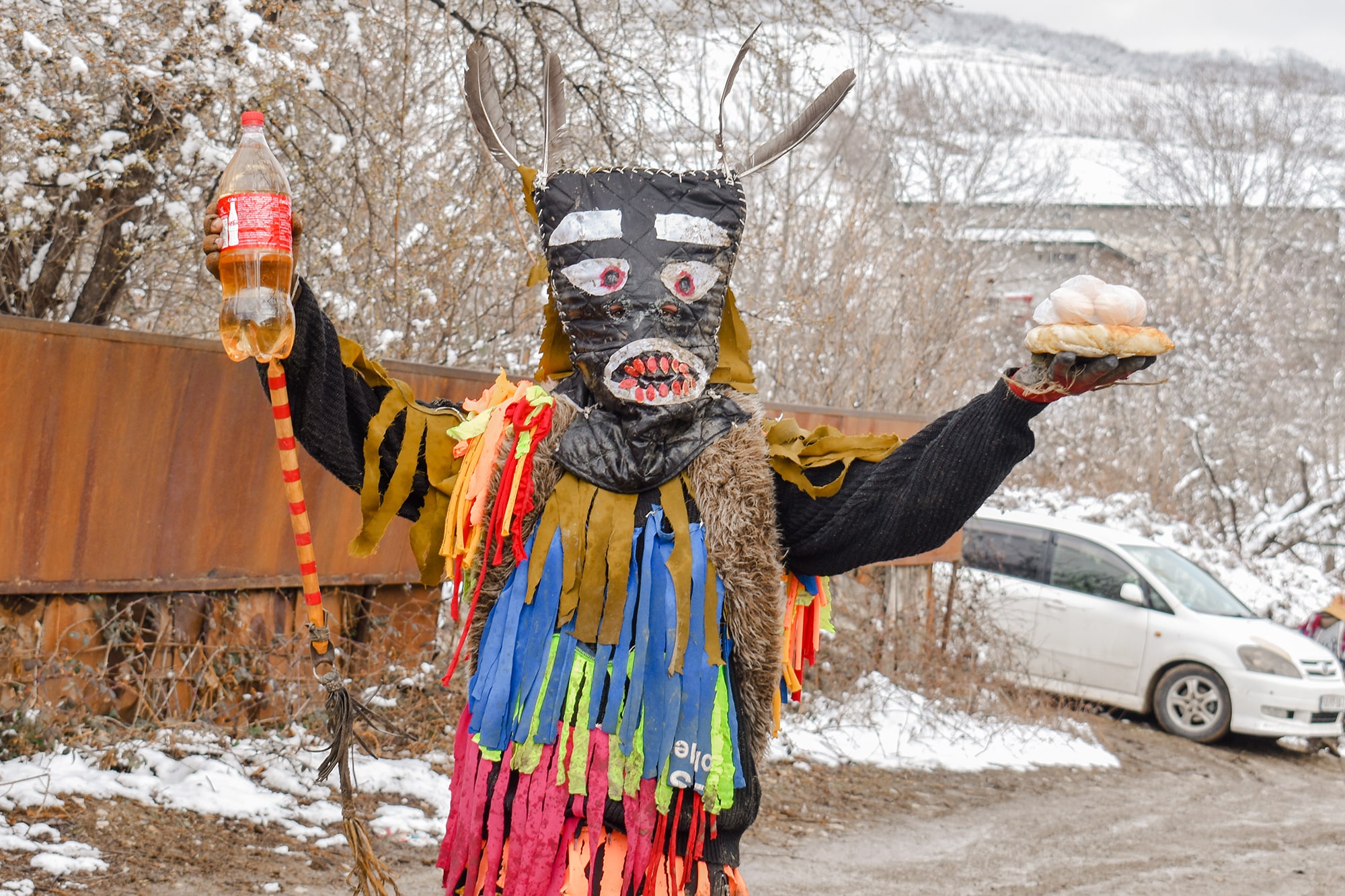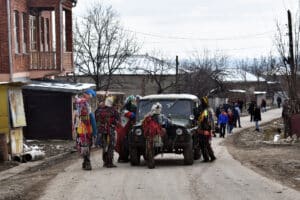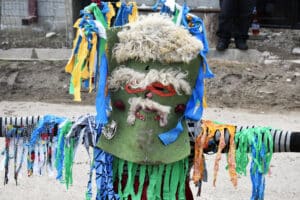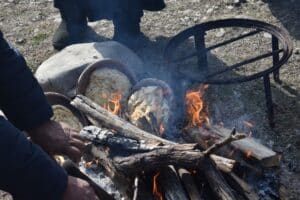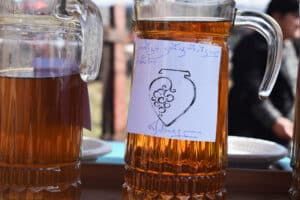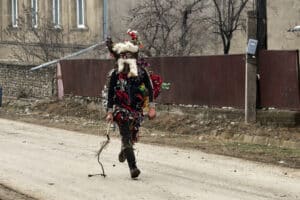Berikaoba is defined by its monstrous-looking masks, good-natured pranking, games and performances of strength, freely shared food and wine, and general festive atmosphere. Although the festival was nearly lost to the passage of time, locals, foreigners, and Georgians from other corners of the country now flock to the Kakhetian villages of Didi Chailuri and Patara Chailuri, whose youths are now fueling a revival of this ruckus and ancient tradition.
What is Berikaoba?
Berikaoba was once celebrated across Georgia. Today, however, it survives in just a handful of villages, namely Didi Chailuri, a small village in Kakheti where local history teacher Eka Chikadze-Veshapidze has helped revive the festival in recent decades.
During Berikaoba, the village is taken over by a band of local boys known as berikas (ბერიკები). They don outrageous costumes that feature a large mask typically decorated with scraps of sheep pelts (or sometimes goat or ox), along with cleverly placed pumpkin seeds that create ferocious facial features. “Horns” are fashioned from feathers and the boys carry long leather whips. These traditional elements: pelts, seeds, and horns are commonly regarded among many cultures as symbols of life, fertility, and/or abundance. Some modern costumes might use additional elements and materials to make a maximally striking costume using what materials are on hand. To act as a berika, a local boy, usually no older than 17, will express interest to the berikas from the previous year that he’d like to take part in the coming year’s festival. While most men who live in Didi Chailuri have participated in the festival as a berika at some point in their lives, it is still a great honor.
Typically starting from the village church (or a different predetermined location), the masqueraders parade through the streets letting out loud shrieks as they whip the pavement with their whips and go door to door playfully demanding goods from the village residents in a sort of chaotic version of trick-or-treat. This sort of noisy, grotesque procession is, again, common in many cultures and is most often seen as a way to scare off malevolent forces by appearing even scarier than they are.
The berikas stop at each resident’s home and collect offerings, eventually compiling a terrific haul of eggs, honey, homemade wine, freshly baked bread, and even a few live chickens plucked straight from their roosts. Today, these gifts are a contribution to the festive atmosphere of generosity and community that pervades the village during the festivities. Symbolically, they are also fueling the good work of the berikas – driving out the bad and securing a place for the good in the village.
As the berikas continue yelping and skipping through the village, they also dole out caresses of mud from their palms onto spectators. Don’t be surprised if you get an unsolicited swipe of cold, gloopy clay to the face — it’s good luck! Many cultures view the soil beneath their feet as not only a symbol of who they are, but also a source of fertility and power. From this soil, their sustenance for the next year will grow.
Fulfilling the tradition of Berikaoba isn’t just the tithes, the masks, and the revelry — it’s the show. A key characteristic of the festival is its element of folk theater; once the procession is finished, the berikas act out a dramatic scene. The scene can vary, but the main premise is usually based on a “wedding” between a chief berika who has been predetermined by the group of berikas and a character known as dedopali (დედოფალი). The word dedopali in Georgian means “queen,” but in the context of Berikaoba refers to a bride. This role is usually played by a teenaged boy who may or may not have also acted as a berika in the earlier procession. Gender reversals are also common in many spring festivals and are generally seen as part of the “rule breaking” and tricksterism that come with them.
During or shortly after the “ceremony,” the antagonist, often depicted as one of the many invading forces that Georgians have previous fought — often a Mongol or Muslim warrior — swoops in and steals the dedopali, killing the chief berika and taking off with his bride. Then, the chief berika revives! He steals back his bride, and all is well — good fortune has been secured for the community, the invader driven out, and the village “bride” secured.
Some years there is much more fanfare put into the performance than others. It might seem like a long scuffle between a few berikas, one of whom has a veil, while other performances might additionally include a priest character and be drawn out with much more narrative, direction, and spectacle. Regardless, there is always the element of a chief berika, a bride, an invader, and an underlying theme of marriage, death, and rebirth to spur on spring.
After the theatrics, the second half of the day consists of many fierce chidaoba (ჭიდაობა) matches, a traditional style of wrestling native to Georgia with its own UNESCO status.
There is also plenty of traditional Georgian food and drink for all. Attendees can try their hand at making churchkhela, a tasty snack made up of a string of nuts (usually walnut or hazelnut) smothered in warm paste made from grape juice that has been thickened with flour known as pelamushi (ფელამუში) or indulge in juicy mtsvadi (მწვადი) kebabs. Other notable treats include kada, a sweet bread native to the Caucasus region often prepared for religious gatherings (known as “gata” in Armenia); in Didi Chailuri, kada is baked over a fire in a ketsi, a traditional clay baking dish. Of course, Kakheti is one of Georgia’s main wine regions, so there are plenty of wines to be enjoyed, some made just up the road in the village, and others brought in from nearby winemakers, all delicious.
Finally, at some point throughout the afternoon, the berikas depart to reap their rewards from earlier in the day, indulging in a feast concocted from all they collected during the procession.
Berikaoba Then
Once upon a time, Berikaoba took place on a much grander scale, with even more elaborate costumes that also varied by region. For instance, jack-o-lantern-esque masks known as kvakhabera (კვახაბერა), made from gourds, were a common feature in Imereti, while in various other villages the boys would have blackened faces and beards of goat hair dangling from their chins. The band of berikas would also feature a ghorberika (ღორბერიკა), or swine-berika, that trotted alongside the group wearing a pelt of pig skin as a cape and the respective pig’s head on a stake. Another notable character was known as a mestvire (მესტვირე), who accompanied the group while strumming the panduri (ფანდური), a traditional three stringed instrument similar to a guitar.
Berikaoba is a fertility rite and so it should come as no surprise that erotica once also played a much more central role. Berikas would don large, phallic representations from their girdles known as konkila (კონკილა). The girdles would also have special little saddlebags known as (ხურჭიანი) to hold their loot.
On the note of costume details, there is great symbolism in the sheep wool often used to decorate the berika masks. The late ethnologist Julieta Rukhadze, who literally wrote the book on Berikaoba, The Folk Holiday of the Revival of the Forces of Nature (ბუნების ძალთა აღორძინების ხალხური დღესასწაული საქართველოში), noted that the cultic and ritual importance of sheep as a garment in agrarian festivals is linked to the significance of herds in ancient Georgia. These were once a primary measure of wealth and a symbol of abundance. For instance, in areas such as Mtiuleti-Gudamaqari, sacred towers were constructed with sheep depictions for worship, while many dwellings from Svaneti to Kakheti were clad with powerful depictions of sheep and rams.
Exactly when Berikaoba came into existence is not known. However, ethnographer Manana Khizanishvili writes that it could date as far back as Georgia’s early farming period around the 6th-4th millennium BC when other such fertility rituals were used for agricultural purposes such as winemaking. Over time, it likely evolved to incorporate the folk theater element and, as Georgia’s history of invaders and conquest evolved, so did the festival.
Like many other folk traditions, Berikaoba slowly disappeared over time and through a variety of means, including Orthodoxy’s disapproval of its heathen elements and the tsars’ discomfort with a festival marked by the overthrow of an outsider. The Soviets also suppressed the festival early on as a part their efforts to snuff out anything that resembled religion and superstition. However, its current revival (pun intended!) began with glastnost in the 80s.
Preserving Berikaoba and How to Attend
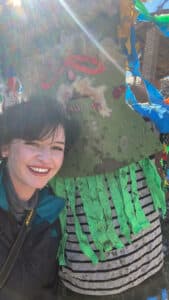
Berikaoba today is a small but again strong tradition thanks to Eka Chikadze-Veshapidze and the youth of Kakheti who have thrown themselves into the festival’s revelry and theatrics.
Curious visitors can even embark on small group tours organized from Tbilisi by the local blogger Red Fedora Diary who also works closely with Eka to ensure the preservation of Berikaoba. You can also reach Didi Chailuri from Tbilisi by marshrutka, just be sure to check the timetables in advance. Visitors should expect festivities to begin around 11 AM and last until mid-afternoon.
Visitors should also strive to be respectful. While everyone should enjoy themselves at Berikaoba, guests should be observant and respectful of the local culture. Joining the festivities should never mean disrupting them. Also, the festival foods are generally complimentary, but thanking and tipping the vendors is highly appreciated and will encourage the continued preservation of one of Georgia’s most fascinating cultural traditions.
More on Spring Holidays From Folkways
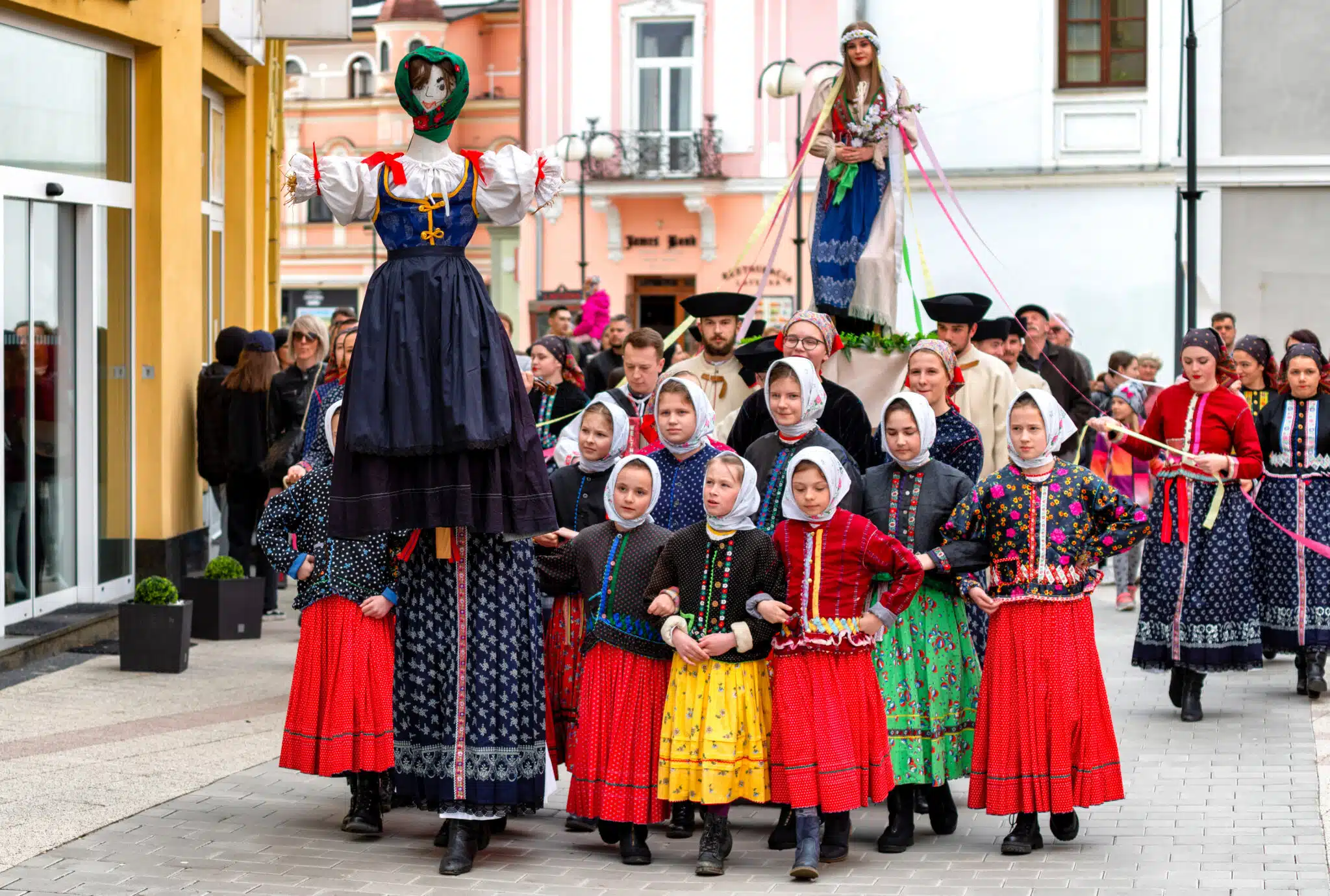
Maslenitsa, Masliana, Meteņi: Spring Holidays of the Slavs and Balts
Rites of welcoming spring and saying goodbye to winter are some of the oldest holidays preserved across Slavic cultures. In the Baltics, the celebrations were nearly lost after being suppressed by Catholic and imperial dominance. Today, Russia’s Maslenitsa is by the far the best-known, but multiple versions exist across the diverse Slavic landscape. In the […]
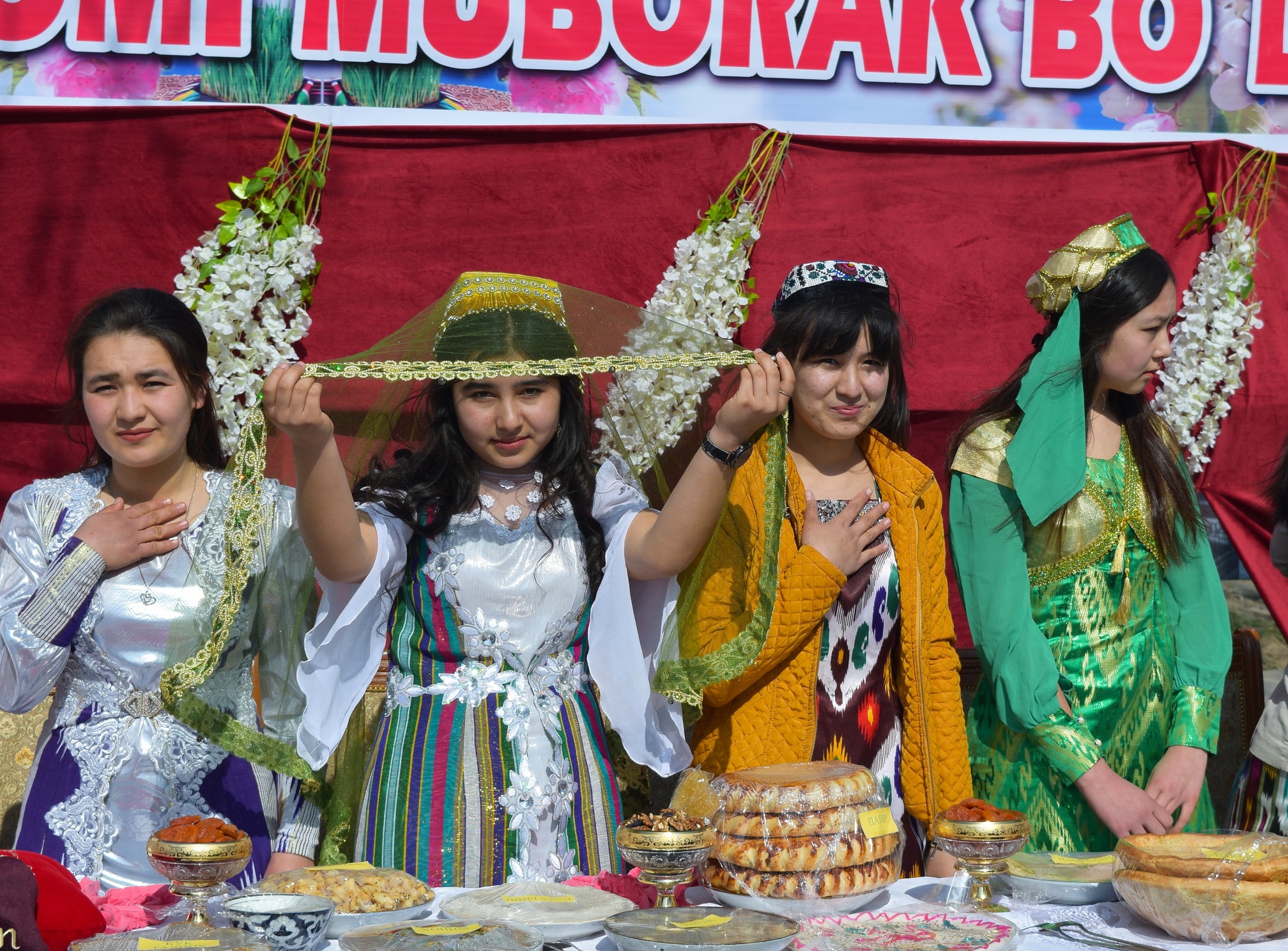
Navruz, Nooruz, Nowruz: The Ancient Spring New Year of Central Asia
Navruz is a spring solstice celebration that marks the beginning of the New Year according to the traditional Persian calendar. It has been a beloved holiday for some 3,000 years, surviving cultural change caused by centuries of tumultuous history. It was once celebrated on the vernal equinox but is now celebrated on the set date […]
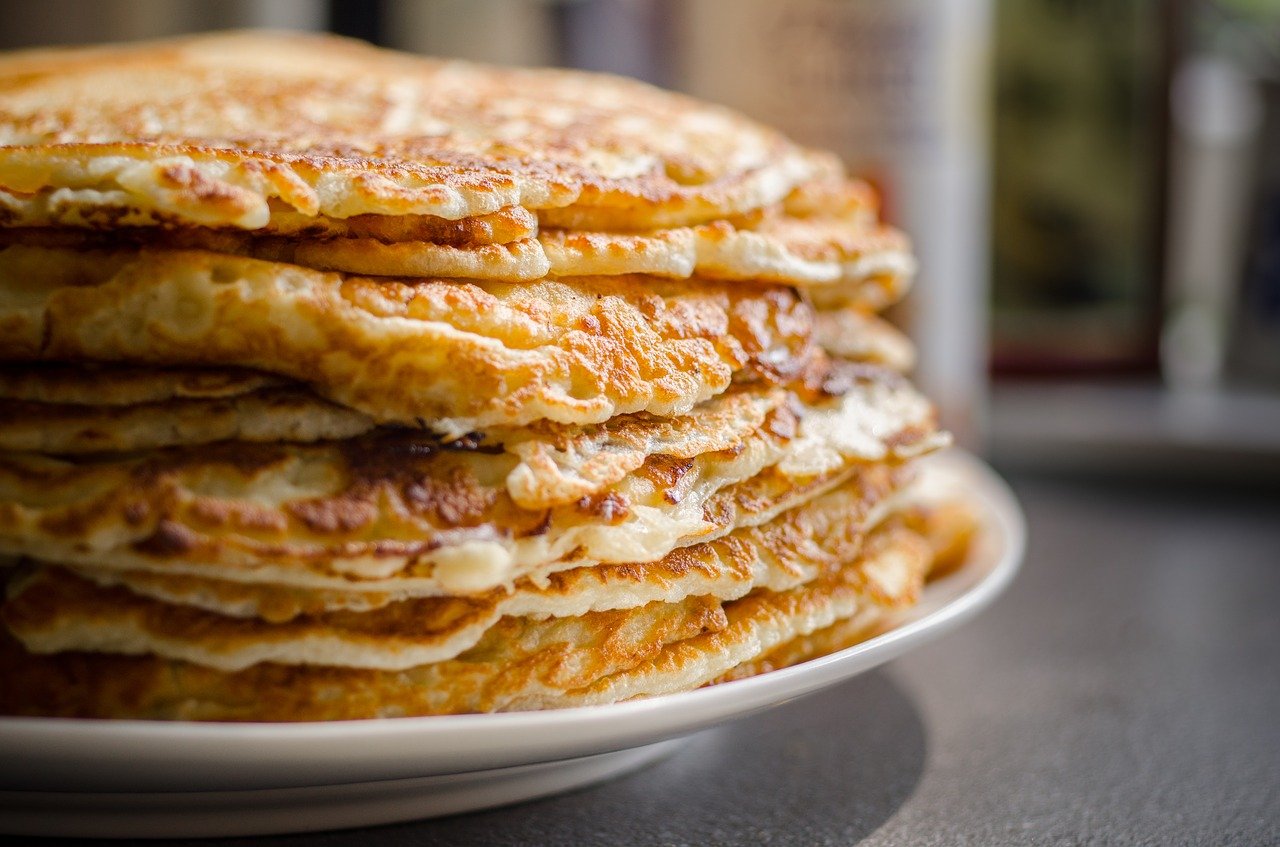
Blini, Mlintsi, Palačinke! Making Slavic “Pancakes”
Blini (блины) are a breakfast favorite in many Eurasian countries. The most basic recipe involves just flour, milk, and eggs. The resulting very thin pancake can be enjoyed in a variety of ways from sweet to savory. Although the recipe is quite simple, they are somewhat labor intensive to make and thus are often associated […]

